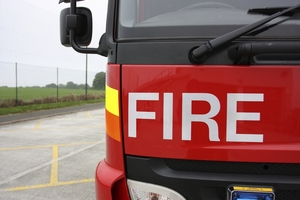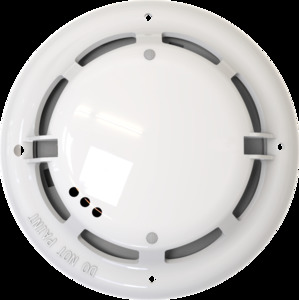

|
Brian Sims
Editor |
| Home> | Fire | >Alarms and Detection | >Multi-Sensor Detectors: Best Practice Guide |
Multi-Sensor Detectors: Best Practice Guide
20 June 2023
OVER THE last few years, the use of multi-sensor detectors has grown in popularity. Due to such detectors’ ability to detect fire at the earliest possible opportunity by combining multiple sensors within one device, installers and end users alike are reaping the benefits, particularly so as they’ve been proven to reduce the UK’s multimillion-pound economic headache of false alarms. Ian Humby elaborates on the fine detail.

We need to recognise some of the key differences, the benefits they might hold for a given building and, importantly, why these systems might well be recommended by the local Fire and Rescue Service.
First things first. What, exactly, is a multi-sensor device? Sometimes known as multi-criteria detectors, multi-sensor detectors combine one or more fire detection technologies into a single device. Different sensing elements detect different components of the fire scenario – ie smoke and heat (and, in some cases, carbon monoxide) – and, therefore, different types of fire.
By combining several sensors into a single device, the need for multiple units is negated, susceptibility to false alarms is greatly reduced, installation costs can be brought down and specification made easier.
Types of multi-sensor detectors
It’s important to remember that not all multi-sensors are created equal. You should look to install devices that are at the top end of your budget and work with installers who are experienced and understand the importance of the right devices – and also their settings – for the right application.
There are multiple (pardon the pun) devices available on the market, which range dramatically in terms of their design. From basic models where there’s limited evaluation of the sensor values right through to sophisticated devices which feature up to several modes of operation, duly assisting qualified installers to select the best day and night modes for the environment in play.
There are also devices available with specific ‘false alarm reduction’ settings, whereby the sensor will automatically adjust the sensitivity of the optical sensing element over time, learning from its surrounding environment from the moment of installation.
A research group involving representatives from the Fire Industry Association, the BRE and several fire detection system manufacturers investigated the immunity of multi-sensor detectors containing smoke and heat sensors to common causes of false alarms, as well as to real fires. In general, it was found that the more sophisticated the optical heat multi-sensors, the less prone they were to common causes of false alarms, while their ability to detect real fires was not compromised in any way.
However, and as mentioned above, all of this is dependent on correct and compliant installation, ongoing maintenance and the right training for the end user to ensure they understand how these devices work.
What is a multi-sensor with carbon monoxide detection?
Many multi-sensors detect heat and smoke, but there are now devices that also detect carbon monoxide. Carbon monoxide detection can be integrated into a multi-sensor to assist with the rapid detection of smouldering fires through the early release of carbon monoxide gas, long before smoke or flames appear.
There are also products that can now make use of their carbon monoxide sensing elements to recognise the threat of carboxyhemoglobin toxic poisoning, commonly referred to as carbon monoxide poisoning (or the ‘silent killer’). It’s called the ‘silent killer’ because the gas is colourless, odourless, tasteless and a non-irritant. If the early signs of carbon monoxide poisoning are ignored, an individual may lose consciousness and be unable to escape danger. In point of fact, more people perish from carbon monoxide exposure than any other kind of poisoning.
What applications would benefit from a multi-sensor fire alarm?
Deploying a multi-sensor which uses a combination of smoke detection, fixed temperature heat detection and rate of rise heat detection is an ideal solution for a variety of applications. Add-in the capability of carbon monoxide detection and carboxyhemoglobin toxic threat detection and you have a true multi-sensor, with the flexibility to provide protection for a wide range of environments (including office blocks, schools, retail premises, hospitals and hotels).
In dwellings such as university Halls of Residence, multi-sensor alarms are recommended in hallways and stairwells adjacent to bathrooms or shower rooms in order to reduce the number of unwanted false alarms. They’re also particularly useful in those buildings with cooking facilities where false alarms can be triggered by causes such as fumes, steam and so on.
Can multi-sensor devices form part of false alarm reduction strategies?
A false fire alarm (or an unwanted fire alarm signal) is defined as an alarm activation resulting from a cause other than a fire on the premises. Several scenarios can realise a false fire alarm: excessive dust, faulty sensors and detectors, steam being misreported as smoke. Even small insects can ‘invade’ a sensor and trigger an alarm condition.
If an automatic fire detector and/or fire alarm system is correctly maintained, it can significantly improve safety by detecting a fire and sounding the alarm at the early stages of a fire’s development.
However, ‘Responsible Persons’ should be aware that, of late, there have been a number of Fire and Rescue Services deciding not to attend automated fire alarms at certain commercial premises unless those alarms are visually confirmed and it’s therefore proven that a fire is present. An automatic fire alarm is a call received from an automatic fire alarm system when triggered by smoke, fire or another fire-related factor. Sometimes however, these systems can also trigger a false alarm.
The Fire and Rescue Services looking after Hertfordshire, Kent, Gloucestershire and Lancashire have all successfully piloted ‘Call Challenge’ schemes in a bid to address the increasing number of ‘false alarms’ attended by their crews. Statistics tell us that the Scottish Fire and Rescue Service attends upwards of 28,000 unwanted fire alarm signals in any given year. No surprise, then, that from 1 July this year, it will no longer attend automatic fire alarm system call-outs for commercial business and workplace premises, such as factories, offices, shops and leisure facilities, unless a fire has been confirmed.
Whenever an automated fire alarm is triggered in office buildings, for example, any Fire and Rescue Service adopting this new approach will now require an independent confirmation from the premises or a passer-by before responding by way of sending fire appliances and crews.
Data collected by the various Fire and Rescue Services during trials has shown overwhelmingly that this approach has cut the number of false alarm call-outs, and in some cases by up to two-thirds. A demonstration that resources can be saved and directed to genuine emergencies. Ultimately, this is all about helping to educate communities on the dangers of fire.
All Fire and Rescue Services have said that any buildings with overnight accommodation presenting a ‘sleeping risk’ (such as hotels and hospitals) will still be attended following alarms raised by automated fire alarm systems.
Specialist system providers
It has been confirmed by the Scottish Fire and Rescue Service that it will treat a signal from a multi-sensor detector as a confirmed fire and will therefore respond automatically. As stated previously, this is because a multi-sensor is looking for more than one indicator of fire (ie heat and smoke and, in the case of the most sophisticated ‘triple sensors’, heat, smoke and carbon monoxide).
If you are the ‘Responsible Person’ for your building, work with your specialist system provider and discuss the application of multi-sensors. They may well play a crucial role in confirming a real fire and help you to negate false alarms.
Multi-sensors in the real world
TV and film studios are often made up of various commercial environments, in turn meaning that they require ultra-dependable and advanced life safety systems to protect employees and visitors alike.
The management team at London’s Riverside Studios in Hammersmith recognised this and made the decision to upgrade the on-site fire detection offer. Hochiki Europe has duly provided some cutting-edge multi-sensors.
Riverside Studios plays host to a TV studio, a cinema and an event area with surrounding bars and restaurants. Having so many different commercial and hospitality environments in one space meant that practitioners at Hochiki Europe’s systems partner Cornerstone Fire Systems needed to think carefully when it came to upgrading the fire detection products across the premises.
Needing to eliminate false alarms, Cornerstone Fire Systems recommended ACD-EN multi-sensors, which continually monitor the surrounding environment to adjust sensitivity. If any transient activity is detected, the sensors automatically switch to the maximum number of samples and quickly determine whether the ‘transient’ is the start of a real fire or a false alarm. This ensures the sensor remains as sensitive as it needs to be.
Neil Thurgood, project engineer at Cornerstone Fire Systems, stated: “The team worked closely with representatives from Hochiki Europe to deliver the most suitable package of fire detection products for Riverside Studios. There were several different elements to consider, from kitchen hazards through to the practicality of organising a large-scale emergency evacuation. We knew that this project would need ultra-dependable products regardless of the environment. We also knew that we may require technical expertise and support. This is something Hochiki Europe could absolutely deliver due to its long-standing reputation in these areas.”
Ian Humby is Head of Sales (UK and Ireland) at Hochiki Europe
*Read the full Riverside Studios Case Study by accessing the Hochiki Europe website
**To find out more about false alarms and how a multi-sensor might be able to help avoid them in the building(s) for which you are the ‘Responsible Person’, head to Hochiki Europe’s website and watch the free webinar on false alarms
- Shedding light
- Hybrid fire safety system from Hochiki safeguards Villa San Carlo
- Fire protection at Edinburgh’s Multrees Walk upgraded thanks to Hochiki
- Sense danger
- Hochiki Europe launches new generation of hybrid wireless fire detection systems under Ekho branding
- The latest in life safety insight
- Hochiki Europe heralds opening of state-of-the-art Training Academy
- Hochiki Europe scores community goal with Medway Soccer Academy
- ESP Intelligent and Latitude ranges occupy centre stage at The Fire Safety Event
- State-of-the-art fire safety for landmark Fjarðargata project in Iceland
- Protecting our past
- Patol aspirating systems protecting your food
- From the editor
- Fire safety returns home to NEC Birmingham
- Building hope
- Blog for FSM website
- Advanced protects National Theatre
- Fire Safety Event 2017 - Live Coverage
- Advances in false-alarm management
- C-TEC rolling out CPD training events













